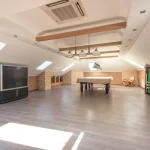When planning to carry out building conversions in conservation areas, it’s crucial to understand the regulatory landscape. Different states and regions have local regulations to protect the environment, and knowing how to navigate these can save you time, money, and legal trouble. With the increasing importance of environmental protection, understanding the regulatory landscape has become more crucial than ever. This guide will explore how to navigate the regulatory landscape in key states such as Oregon and Florida, focusing on areas of land planning, water conservation, and wildlife habitat protection.
Understanding Land Planning
Land planning is the primary step in any building conversion. It involves analyzing the potential impact of the proposed development on the local environment and community. In states like Oregon, this is a regulated process that requires careful consideration.
Topic to read : What Is the Impact of Remote Working Trends on Suburban Real Estate Prices?
Land planning in Oregon is based on a statewide approach. The state’s Land Conservation and Development Commission (LCDC) oversees land use planning, ensuring the protection of the state’s land resources and promoting sustainable development.
Before you can begin any building conversion in Oregon, you must prepare a comprehensive land-use plan. This plan must comply with the 19 statewide planning goals that cover issues like citizen involvement, agricultural lands, and coastal resources. It should also address local issues, including the protection of local wildlife and their habitats.
Have you seen this : What Strategies Can Maximize Retention Rates in Luxury Apartment Communities?
When preparing your land-use plan, seek advice from local planning departments and environmental professionals. They can help you understand the state’s requirements and avoid potential pitfalls.
Water Conservation in the Sunshine State
Water conservation is a crucial aspect of the regulatory landscape, especially in states like Florida, where water scarcity is a significant problem. The state’s Water Management Districts (WMDs) oversee water resources, ensuring their efficient use and protection.
Before starting any building conversion in Florida, you need to understand and comply with the state’s water conservation regulations. This typically involves preparing a water management plan as part of your project proposal.
The plan should outline how you intend to manage water resources during and after the construction phase. This includes detailing measures to reduce water use, prevent pollution, and protect local water bodies and wildlife habitats.
Consult with local WMDs and environmental professionals when preparing your water management plan. They can provide invaluable guidance and ensure your plan is compliant with state regulations.
Wildlife Habitat Protection
The protection of wildlife habitats is a critical aspect of environmental conservation. When planning building conversions in conservation areas, you need to understand relevant wildlife habitat protection regulations. These vary by state and local jurisdictions.
For instance, in Oregon, the Department of Fish and Wildlife oversees wildlife management, including the protection of species habitats. Before undertaking any building conversions, you must assess the potential impact of the proposed development on local wildlife and their habitats.
Similarly, in Florida, the Fish and Wildlife Conservation Commission oversees wildlife habitat protection. Any building conversions must not adversely affect protected species or their habitats.
In both states, you may need to carry out environmental impact assessments and surveys to identify any potential impacts and propose mitigation measures.
Engaging With Local Regulatory Bodies
Engaging with local regulatory bodies is a crucial part of navigating the regulatory landscape. These bodies have the authority to approve or reject your building conversion plans based on their adherence to environmental conservation regulations.
In Oregon and Florida, several local and state agencies oversee land use planning, water conservation, and wildlife habitat protection. These include the LCDC, WMDs, Department of Fish and Wildlife, and Fish and Wildlife Conservation Commission.
Regularly engaging with these agencies can help you better understand the regulatory landscape and ensure your plans are compliant. It’s also a good idea to involve them early in the planning process, as their insights can help shape your plans and avoid potential regulatory challenges.
Complying With Environmental Protection Plans
Complying with environmental protection plans is another crucial aspect of the regulatory landscape. These plans, which are often developed by state and local agencies, outline strategies for managing and conserving environmental resources.
In Oregon, for instance, the state has developed the Oregon Conservation Strategy, which provides a blueprint for conserving the state’s fish and wildlife and their habitats. Adhering to this strategy can help ensure your building conversions are sustainable and compliant with state regulations.
Similarly, in Florida, the state has developed the Florida Wildlife Action Plan, which outlines strategies for conserving the state’s wildlife and their habitats. Complying with this plan can help ensure your building conversions are environmentally friendly and do not adversely affect local wildlife.
In both states, working with environmental professionals can help you understand and comply with these plans. They can provide expert advice and guidance, ensuring your project is sustainable and compliant with local regulations.
Engaging in Sustainable Energy Practices
Adopting sustainable energy practices is an additional way to navigate the regulatory landscape when converting buildings in conservation areas. Reflecting a global shift towards renewable energy, states including Oregon and Florida have implemented regulations promoting clean energy usage.
In Oregon, the Department of Energy oversees energy production and conservation with regulations intended to minimize environmental impacts. Understanding these can be crucial to your land planning process. For example, the adoption of renewable energy technologies, such as solar panels or wind turbines, might enhance the approval chances of your conversion plan. The state’s Renewable Energy Action Plan provides a framework for understanding Oregon’s goals for clean energy and can be a valuable reference throughout your planning stages.
Florida, known for its abundant sunshine, encourages solar energy usage. The state’s Solar Energy System Incentives Program provides financial incentives for the installation of solar energy systems, making it an attractive option in building conversions. Additionally, following the Florida Energy Conservation Plan can help ensure your project aligns with the state’s energy conservation goals.
Balancing Commercial and Industrial Interests With Conservation
A key aspect of the regulatory landscape for building conversions in conservation areas is balancing commercial and industrial interests with conservation. The Columbia River Gorge in Oregon, for instance, has seen significant land development, with both the Oregon Department and local governments playing vital roles in ensuring that industrial development does not endanger species or harm wildlife habitats.
When planning a building conversion, it’s crucial to consider the potential commercial and industrial impacts on natural resources. For instance, converting a historic building into a hotel in a conservation area like the Columbia River Gorge may increase tourism—providing economic benefits but also potentially straining local resources.
In Florida, similar considerations arise when converting buildings on the state’s numerous golf courses. While these conversions can provide commercial benefits, they must be done responsibly to protect water quality and wildlife habitats.
Navigating the regulatory landscape for building conversions in conservation areas can be a complex process, but understanding key areas of land planning, water conservation, and wildlife habitat protection can make it more manageable.
In states like Oregon and Florida, engaging with regulatory bodies, complying with environmental protection plans, adopting sustainable energy practices, and balancing commercial and industrial interests with conservation can be critical for successful building conversions.
Remember, it’s not only about following regulations—it’s also about contributing positively to the conservation efforts in these areas. By understanding and respecting the regulations in place, we can ensure that development does not come at the expense of our precious natural resources.











